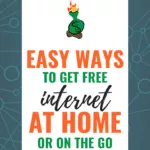Internet service is essential in most households today, but it can get expensive! No matter how much money you make, there’s no sense in wasting money on services you can get for free or at a discount. To keep the internet affordable, we used to switch providers to be a ‘new customer’ every other year. This allowed us to avoid the hike in internet service providers’ pricing and enjoy the specials new customers received. After we got tired of switching and determining if we were eligible customers for the new special, we signed up for Hulu Live.
The average household spends $50 monthly on their internet access, and that’s before overage prices, mobile data usage, or other costs. That’s $600 a year you could save! Gaining financial independence and being able to retire early isn’t just about increasing your income potential; it’s also about reducing your expenses too.
You may be wondering how to get free internet illegally, but you won’t find any of that information here! With this in mind, we’ve put together a selection of ways you can find free internet service legally in any location. No matter whether you’re at home or on the go, try these savvy ways to secure free internet now.
Table of Contents
Is There a Way to Get Free Internet?
1. EveryoneOn.org
EveryoneOn is part of the Connect to Compete program, run by the Federal Communication Commission (FCC). Designed to make internet services available to people who otherwise wouldn’t be able to afford an internet connection, EveryoneOn is ideal for low-income households and is one of several government assistance programs.
The scheme is particularly aimed at students because the FCC recognizes that access to the internet is vital when you’re studying. Determined to ensure all students have the same opportunities to excel at school, they offer free and low-cost internet services to disadvantaged people.
This makes them a top choice as an internet service provider, although the service is for 10 Mbps, it will help you break the digital divide! But don’t get caught up on the internet speeds, this is cheap internet regardless. You can check to see if you have fast internet by running a speed test that checks upload speeds and download speeds.
Although there are eligibility criteria in place, it’s certainly worth checking to see if you qualify. EveryoneOn.org links to PCs for Everyone, so you may even find you’re entitled to help with hardware too. It only takes a second to check your eligibility, so it’s worth finding out if you could benefit from free internet service at home under the EveryoneOn.org program.

2. FreedomPop
If you want to know how to get internet for free at home without paying and how to get free internet on the go, check out FreedomPop. As one of the most popular ways to get free internet, you’ll find plenty of users are already benefiting from its services.
Based in Los Angeles, FreedomPop is simply a mobile and wireless internet provider with a difference. Their data, text and talk plans start from just $0.00 a month. Yep, you read that right – you could be paying $0.00 a month for your internet! So this is your answer: ‘ how can I get absolutely free internet.’
When you set up an account, you’ll pay a small deposit, and FreedomPop will send you the equipment you need. If you want to access free internet on the go, you can purchase a mobile phone from them or simply use their SIM card in your existing device (providing it’s unlocked).
Currently, FreedomPop is offering 2GB of free data for the first month, followed by 500MB of data every month thereafter. If you’re using a GSM SIM card, however, this is reduced to 200MB data.
While the allowance doesn’t equate to a vast amount of data, it’s ideal for users who don’t spend a lot of time on the internet. If you only check your emails a few times a day and do a little shopping online, for example, you should be fine with the amount of free data provided.
For users who need more data, FreedomPop to offer low-cost plans to suit your usage. However, you’re under no obligation to sign up for any of these. If you want to stick with your free allowance and get free internet service at home and on the go, you totally can.
3. WifiMap App
Perfect for when you’re out and about, WifiMap is an intuitive app that makes it easy to find free wifi hotspots. The app already has over 100 million locations available with free wifi, so there’s a good chance you’re going to find one close to you.
What makes it even better is that WifiMap takes a crowdsourcing approach to its inventory. Users upload the location of wifi spots so that other people can access free internet on the go. As more users sign up and share free wifi locations, the database will continue to grow.
Featured in major publications, WifiMap is soaring in popularity, so you can expect more free internet locations to pop up all the time. Simply download the app, search in your desired area, and you’re good to go!
4. NetZero
If you’re old enough to remember dial-up internet, chances are you’re already familiar with NetZero. Established in 1998, the company’s still growing strong and now provides a decent amount of free internet access for its users.
If you’re keen to find out how to get free internet at home without paying, NetZero is a great option. You’ll get 10 hours of free internet a month, which isn’t too shabby when you’re considering how much you’re paying (nothing!). With low-cost options for users who want to wireless access to the internet for more than 10 hours a month, using NetZero could be an excellent way to reduce your internet bill.
However, NetZero still offers dial-up internet services, so you will need a phone line if you want to take advantage of their free internet. Of course, dial-up internet is never going to be as fast as more modern connections, so it can be a bit jarring when you first make the switch.
While the dial-up nature of NetZero isn’t going to satisfy gamers or users who want to watch a lot of video content online, it’s an excellent option for free internet if you don’t mind slightly longer loading times. You’re not a vociferous user of the net.
5. Wifi hotspots
Although Wi-Fi hotspots have been around for some time, their availability has increased in recent times. In fact, you’ll be hard-pressed to go to any large location and not find a free internet wifi hotspot, so it’s easy to find places with free Wi-Fi today.
Coffee shops and cafes are always popular haunts for free internet users because they typically offer public wifi hotspots. You’ll also find them in restaurants, shopping malls, airports, healthcare clinics, schools, colleges, universities, libraries, museums, and event venues.
If you have a cell phone contract, be sure to ask your provider if they offer free internet via wifi hotspots. They’re not always advertising very well, but the vast majority of cell service providers do offer a free wi fi hotspot too. This will allow you to get online and connect to the internet from anywhere.
Perfect for when you’re out about and want a wifi access point, it’s always good to keep an eye out for free wireless internet hotspots.

6. All Free ISP
When you’re asking how to get free internet at home, All Free ISP provides the answer. While they don’t offer free internet themselves, they’ll connect with multiple suppliers who do. All Free ISP gives you the information you need to access free and low-cost internet at home.
With reams of free internet providers, you simply need to enter your zip code or state to find out what’s available in your location. What makes All Free ISP so useful (aside from enabling you to access free internet!) is the user reviews it features on its website.
Other users have helpfully submitted reviews, so you can check out the level of service on offer before you sign up for anything. When you’re looking for a reliable free internet provider, this information is invaluable, so be sure to check out the user reviews before you choose a service.
7. Juno
Juno is another service that offers free internet service, but the only catch is the free internet service they offer is for dial-up. Like NetZero, they offer ten free hours of internet service monthly. While dial-up isn’t the fastest, it’s not a bad deal given you don’t have to pay for it.
The internet service is ad-supported to offer this free service, which means you’ll see ads while surfing the internet, but since you aren’t paying for it, that can be a nice tradeoff.
8. Free WiFi Near Me: Use Your Cell Phone as a Hotspot
If you have a cell phone contract, it’s highly likely you’ll have some data as part of your monthly package or bundle. In many cases, people have access to GBs of data a month that they simply don’t use. If you’re paying for it anyway, why not use it?
Depending on the make and model of your phone, you might find it easy to access the internet straight from your device. However, you can also use your phone service as a router by connecting your laptop or PC to your phone. You’re browsing the internet while using your cell phone data!
If you regularly have unused data that doesn’t roll over on your cell phone package, this is a great way of getting the most out of what you’re already paying for. In addition to this, many cell phone providers offer packages with unlimited monthly data plans.
Depending on the costs involved, you might find it more effective to upgrade to an unlimited data plan and use your phone as a hotspot, rather than paying for a separate internet connection at home.
The beauty of using your phone as a hotspot is that you can access the internet wherever you take your phone. If you want to know how to get free internet at home or on the go, there’s your answer!
However, if you don’t have an unlimited plan, do be careful not to exceed your data usage allowance. Using data that is outside of your allowance can be a costly way to access the internet, so you’ll want to avoid this altogether.
Many cell phone providers allow you to set data limits, which minimizes the risk of exceeding your free usage allowance and prevents you from racking up charges.
9. Look for a Municipal Wireless Network
Since having internet access is more essential than ever before, many government organizations are committed to providing free internet access to everyone who needs it. Municipal wireless networks are typically used to connect businesses and government offices, but they’re often extended to individuals too.
Municipal wireless internet service providers are most commonly found in larger cities and towns. Still, the idea is proving to be so effective that they’re being used in more and more areas. If you’re not sure if there’s one nearby, it’s certainly worth finding out.
While some areas do have eligibility criteria that limit universal access to free internet via municipal wifi networks, others offer free connectivity to everyone. Depending on your circumstances and local network availability, this could be a great way to access free internet.
10. Share a Connection
If your neighbors are already paying for an internet connection, why not see if they’d be willing to share? While many neighbors agree to split the cost of accessing the internet, you could offer your services in exchange for access to their connection.
If you’re a talented gardener, for example, your neighbor may be happy to share their internet in exchange for you tending their flowers or mowing their lawn. Alternatively, you could offer to carpool to work in exchange for accessing their internet.
Although sharing a connection can be a great idea, it is dependent on your relationship with your neighbors. What’s more, it’s only really a viable option if there is an unlimited plan in place. Otherwise, you could end up quibbling over who’s using more data!
11. Affordable Connectivity Program
The Affordable Connectivity Program is a part of the Bipartisan Infrastructure Law introduced by the White House – President Biden and Vice President Harris and replaced the Emergency Broadband Benefit. The bill provides qualifying families a $30 credit off their internet bill monthly and a one-time $100 discount to purchase a laptop or computer.
The plans are for free high-speed internet compatible for a family of four to work, stream TV, and play video games. They partnered with over 20 providers, including AT&T, Comcast, Verizon, Wow, and Cox Communications.
You’ll likely be eligible if you already receive government assistance, such as SNAP or Medicaid, or qualify for Head Start. If not, you can qualify based on your household income. Your household income must be less than 200% of the Federal Poverty guidelines. For example, a family of four might qualify with an income below $55,500.
You can apply for the program online or via mail. Also, if you already have high-speed internet and your provider participates in the program, you can apply directly through them.
If you don’t apply directly through your provider, you can contact a provider and start your discounted plan once you receive approval.
12. Lifeline
Lifeline is another FCC affordable connectivity program that helps low-income families. They offer discounted internet, telephone, or bundled services purchased from participating providers. Eligible households will receive a discount of $9.25 per month on wireline or wireless service.
The Universal Service Administrative Company administers the program. Eligible households must have income no higher than 135% of the Federal Poverty Guidelines or be a part of one of the federal assistance programs, such as Medicaid or SNAP.
How Can I Get Free WiFi?
Many internet providers have special programs available for assisting low-income families and can help you learn how to get free Wi-Fi at home. Review the list below to see if any of these companies offer free service or discounted service to families in your area.
Altice Suddenlink / Altice Optimum Internet
Altice is offering new qualifying customers the opportunity to try out their 30 Mbps broadband plan for free. This offer can be used by anyone in a household with students of any age, and it’s available across Altice regions (Optimum and Suddenlink). Their special program is called the Altice Advantage.
AT&T Internet
The AT&T Access program allows low-income families to get unlimited data for 60 days when they sign up for a tablet. They’re also offering $10 million in funds and free telehealth services, special deals with first responders including them giving out smartphones with their unlimited plan.
Comcast Xfinity Internet
Xfinity’s Internet Essentials program is an incredible value with a $9.95 monthly fee for those who qualify, and Comcast has increased the speed available to the program in response to this pandemic that will be permanent!
Cox Internet
Cox has a program called Connect2Compete that gives you affordable internet with up to 50 Mbps download and 3 Mbps upload speeds. This also unlocks access to over 3 million wifi hotspots and includes a wifi modem provided by them. Currently their basic plan is available for two years at just $9.95 per month.
HBC Internet
HBC currently is offering two months free of broadband internet to families with students who qualify. This special internet assistance program has been in place for low-income families for over 10 years.
Mediacom Internet
Mediacom also participates in the Connect2Compete program for families that qualify. With speeds up to 25 Mbps, this $9.95/mo program may be a good option for you and your family.
T-Mobile Project 10 Million
If your child is on the National Lunch School Program at your school district (free lunch), or your household is on any other government programs, such as SNAP or Medicaid, you may qualify for free internet through T-Mobile. Project 10Million provides free 100GB of internet monthly for five years upon approval. In addition, your household will receive a free hotspot with no activation fees, shipping, or recertification requirements.
Verizon Internet with ACP and The Verizon Forward Program
Verizon is a partner of the Affordable Connectivity Program. If you apply and get approved, your next step is to see if Verizon is available in your area. If it is, or you’re already an existing customer, contact Verizon to get the discounts you’re approved for through the ACP. Many Verizon customers that qualify for the program get internet for free.
Safety Tips for Free Internet
Free internet is great, especially for low-income families; however, there are certain risks when using public Wi-Fi. To keep yourself safe, consider these tips.
Don’t Share Personal Information
Avoid sharing personal information, including your Social Security number, birthdate, important passwords, and credit card numbers. If you must share personal information, ensure the website is encrypted. Unselect “Connect Automatically”
Don’t let Wi-Fi connect automatically. This puts you in charge of which connection you use, especially when sharing private information. Choosing which connection to use is an extra step, but it’s worth your safety.
Shut Off Air-Drop and File Sharing
If you keep air-drop or file sharing on when you’re on a public network, other computers can hack into your files and access your private information. So to retain your privacy, shut those features off if using a public network.
Use Secure Sites
Secure sites start the web address with https, not http. So before entering any information, look at the site’s address to look for the https. Also, while browsing the site, ensure the website address remains the same and doesn’t refresh to an unencrypted site, as some hacker sites will make you feel safe but then switch it without you realizing it.
FAQs
How Do I Get Free Internet at Home?
Read our comprehensive guide above to see which programs you may qualify for. Getting free internet vastly depends on your location and eligibility requirements.
How Do I Find Free Internet Near Me?
Finding free internet near you is based on the providers available in your area. We suggest you reach out to your known local providers to see if they have any no or reduced cost programs that you may be eligible for.
How Can Students Get Free Internet?
Most of the methods outlined in this post are available for low-income families with children in school. This includes college students. Through the Connect2Compete program offered by Cox and Mediacom, many are able to receive reduced cost internet.
How Do I Know If I Qualify for Low-Income Internet Assistance?
To qualify for low-income internet assistance, your household income must be below 200% of the federal poverty level, or you must already be enrolled in a government-assistance program, such as:
- Supplemental Nutrition Assistance Program
- Medicaid
- Public Housing
- Supplemental Social Security Income
- Temporary Assistance for Needy Families
How Do I Get a Free VPN for My Internet?
How Can I Get Free Internet Without a Provider?
If you need access to free internet access but don’t have a provider, consider asking your neighbor for Wi-Fi access. This isn’t abnormal, as neighbors share things often, and if you have something you can exchange with your neighbor for the internet access, it can be a win-win for everyone.
Will the Government Pay for My Internet?
There are many government programs that offer discounts that amount to free or discounted internet from participating providers. While they won’t pay for your internet directly, you may have access to quality government programs if your household qualifies for low-income internet.
Is the Internet Free in the U.S.?
Technically, the internet isn’t free in the United States, but there are completely legal ways to get free or discounted internet from well-known internet providers. The key is seeing which programs you qualify for and how to apply to get more affordable internet.
The Bottom Line
Knowing how to get free or discounted internet at home and on the go can save you a significant amount each year without risking your internet connectivity. As you can see, there are many low-cost internet plans that allow you to stay connected without facing high internet bills.
Whether you qualify for free internet access from participating providers or low-cost internet, you could put a lot more money in your pocket each month, helping you reach your goal of financial independence.
Samantha Hawrylack is a personal finance expert and full-time entrepreneur with a passion for writing and SEO. She holds a Bachelor’s in Finance and Master’s in Business Administration and previously worked for Vanguard, where she held Series 7 and 63 licenses. Her work has been featured in publications like Grow, MSN, CNBC, Ladders, Rocket Mortgage, Quicken Loans, Clever Girl Finance, Credit Donkey, Crediful, Investing Answers, Well Kept Wallet, AllCards, Mama and Money, and Concreit, among others. She writes in personal finance, real estate, credit, entrepreneurship, credit card, student loan, mortgage, personal loan, insurance, debt management, business, productivity, and career niches.



Thomas Z
Sunday 21st of February 2021
You just saved my family hundreds of dollars a year!! From the bottom of my heart thank you
Duot Garang
Friday 25th of September 2020
Thanks for the valuable information!
Jamie
Friday 28th of August 2020
So what is the fire plan? And thanks for yhe info...Im about to start a blog myself, and would love to know more about your story and how you were able to get to a place of full time blogging.I have been dreaming of this lifestyle, entrepreneurship as a woman. And advice from a novice would be grrat thanks for your informative post....
Ed Frez
Tuesday 18th of August 2020
Thank you for all of these tips. I think you just saved me $39.99/mo!